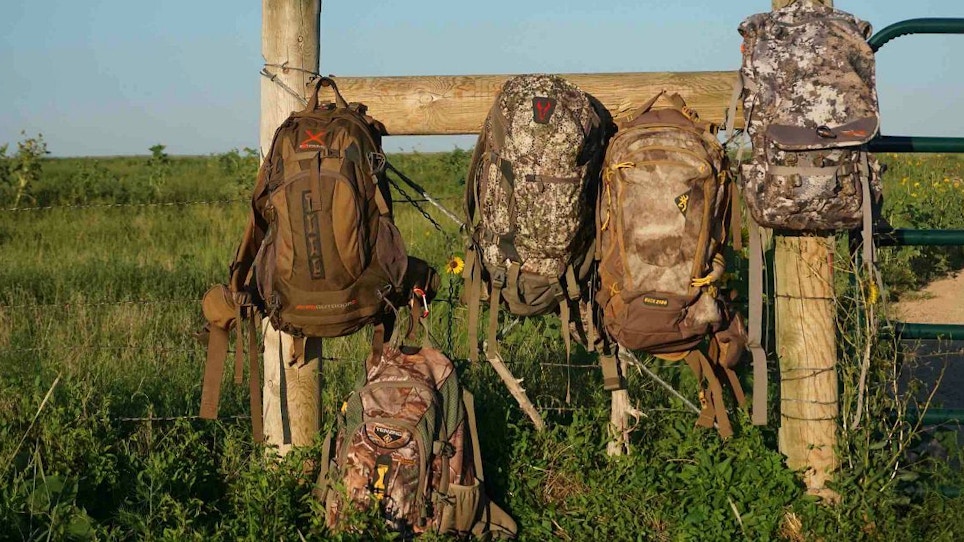Bowhunters carry a litany of purposeful gear: knives, headlamp, wind detector, camo face paint, water, snacks, first aid items, flagging tape . . . need I go on? If we don’t have a good pack, our gear isn’t organized, we can’t get to it efficiently, we don’t traverse terrain in comfort, etc. A good pack is not a want — it’s an absolute necessity.
Of course, there are different packs designed for different hunts — day hunts, backpack (overnight) hunts, bivy (extended stay) hunts — with the most common of the three being day hunts. For this reason, I chose the daypack for this particular field test. Daypacks are used across the country by bowhunters chasing whitetails, bears, mule deer, hogs and other game animals. Below are my findings regarding some daypacks you may want to wrap around your shoulders in the coming months.
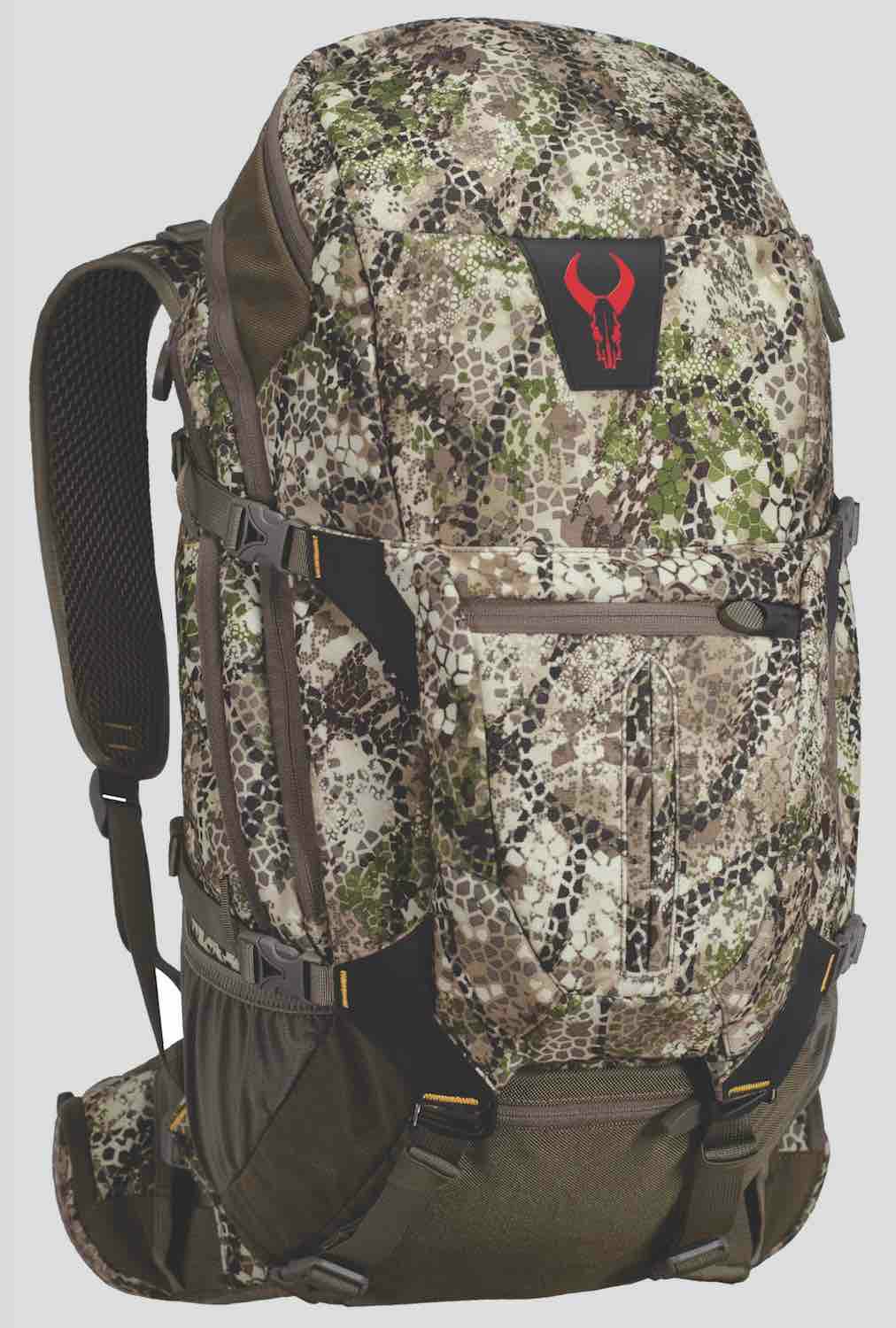 Badlands Ascent
Badlands Ascent
(800) 269-1875; www.badlandspacks.com
Pack Specs: 2,430 cubic inches; 4.5 pounds; hydration-reservoir compatible; $250
Comfort/Adjustment
I am that bowhunter that takes the proverbial kitchen sink with me wherever I go, so I demand a pack that is comfortable and allows for easily customizable shoulder and waist adjustment. The Ascent gets my nod of approval in the comfort/adjustment arena. Top and bottom shoulder-adjustment tabs allow the wearer to situate the load perfectly on the hips. Waist-belt adjustment is a breeze, and the excess waist strap can be tucked away via the included stretchable holders so you don’t have excess straps grabbing trees and other vegetation as you walk. The pack also boasts a single strap across the chest. The waist belt and shoulder straps are padded, breathable and proved ultra-comfortable during a 5-mile off-road trek even when I loaded up 25 pounds of gear. I also appreciated the pack’s all-new ventilated suspension system, which features a pair of padded mid-back support pads with an open (ventilated) area running right along the spine. It boosted airflow and proved mighty comfortable.
Pockets
I love a pack with purposeful pockets, and the Ascent has them in spades. A pair of perfectly sized waist-belt pockets hold gear like wind powder, face paint, a headlamp, a GPS and the like. The Ascent also boasts a pair of stretchable, open side pockets that are perfect for a water bottle, snacks and other gear. A pair of vertical side pockets grace the side of the pack, which I found to be ideal storage for my rain gear, Thermacell, knives and bone saw. The pack has two main compartments — the first sporting an included rain cover (loved this feature) and an additional zippered upper pocket. The second main compartment also boasts a larger upper zippered pocket (larger than the one in the first main compartment), as well as a hydration-bladder compartment. A reverse bucket lid opening promises ultra-easy access to the second main compartment. Lastly, the pack boasts a small pocket located on the all-new Bow-Wrap Carrier System (more on this in a bit) that is ideal for smaller necessity items. This pack feels bigger than 2,430 cubic inches. Why? Because the pocket design is so purposeful, and the main compartments are open and airy.
Durability
I put the Ascent through a 5-mile hike loaded with 25 pounds of gear. It remained comfortable and handled the load with zero problems. I had no issues with buckles, straps or zippers. I also sent the pack, after unloading my gear and replacing it with three 30-pound sand bags, rolling 25 feet off a cliff. Other than a slight scar on one of the plastic waist buckles, the pack showed no signs of damage.
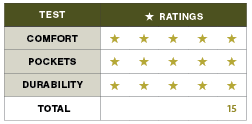 What I Loved
What I Loved
I love to transport my bow on my back, but am often reluctant to strap my rig to the back of my pack. In the past I’ve seen this method rub my strings and cables, mess with my D-loop and not hold my bow secure. Enter the all-new Bow-Wrap Carrier System. Attached to the outside of the pack, this padded enclosure covers your cables, rest and part of the riser — depending on how you choose to attach it. The system sucks the bow tightly to the pack and provides the type of support required without damaging strings and cables. As with many Badlands models, the pack features a rollout pocket which holds the bottom cam.
Ideal For:
This pack is ideal for the spot-and-stalk bowhunter who also likes to jump in a treestand or ground blind from time to time.
 Alps Outdoorz Pursuit X
Alps Outdoorz Pursuit X
(800) 344-2577; www.alpsoutdoorz.com
Pack Specs: 2,700 cubic inches; 3 pounds 15 ounces; hydration-reservoir compatible; $170
Comfort/Adjustment
The Pursuit X offers molded foam suspension and Lycra shoulder straps with load lifters to add additional comfort while you’re toting a load. Mission accomplished. This pack rides well, offering top and bottom shoulder-strap adjustment as well as a padded, adjustable waist belt and chest strap. The molded waist belt conforms to the body, and I really appreciated the fact that Alps went the extra mile when creating the raised and heavily padded lower pack support pad. During my 5-mile off-road hike, the pack seemed to get more comfortable as I went. I would like to see a tad more mid-back support, but overall this pack proved a joy to tote.
Pockets
The Pursuit X boasts two ideally sized waist-belt pockets, as well as a pair of side mesh pockets. These pockets are sizeable, holding my water bottle and other gear easily. The front compartment offers a number of outside tie-off points, and inside one finds a zippered mesh storage pocket (great for immediate access to critical gear) and a pair of non-zippered mesh pockets. The main compartment is big and, besides the hydration-bladder storage pocket, totally open. I really liked this feature. I like a big, open pocket where I can store lots of gear. The main pocket also provides access to the center aluminum stay, which I found boosts the comfort and overall ride stability of the pack when left in. Though they’re not pockets, I tipped my hat to the included D-ring clip integrated into the top of the pack. It was perfect for hanging this pack in a treestand. I also enjoyed the bungee and cord lock systems. I was able to attach a jacket to one side of the pack and a quiver to the other. The pack also boasts a pair of bottom pockets — one provides access to an included rain cover and the other to the pack’s bow-holder pocket. I appreciated the fact that the bow-holder pocket featured a strap that allowed me to snug the pocket around the cam. Though not as secure and protected as I’d prefer, attaching my bow to the back of the pack would be fine for shorter jaunts.
Durability
Constructed from 1680D nylon ballistic fabric, this pack was a tank. I had zero zipper, buckle or strap problems, and the pack took the tumble off the cliff like a champ. I also appreciated the large over-molded rubber grips attached to each external zipper. This made zipper operation easy and allowed ultra-quick access to compartments.
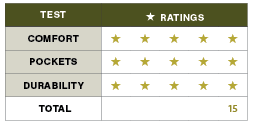 What I Loved
What I Loved
Besides the obvious, I really appreciated the numerous lashing points and the bungee and cord lock design. As previously mentioned, I haul lots of gear, and being able to attach some of that gear to the outside of this pack without the worry of it falling off or rotating and making the pack uncomfortable was awesome. The four Hypalon stress points running vertically up the pack’s front pocket were a great place to attach my jacket and rain gear.
Ideal For:
This pack is a spot-and-stalk gem. It does work in a tree, but besides the D-Ring clip I found it rather large and cumbersome when 20 feet up. It’s also perfect for a ground blind.
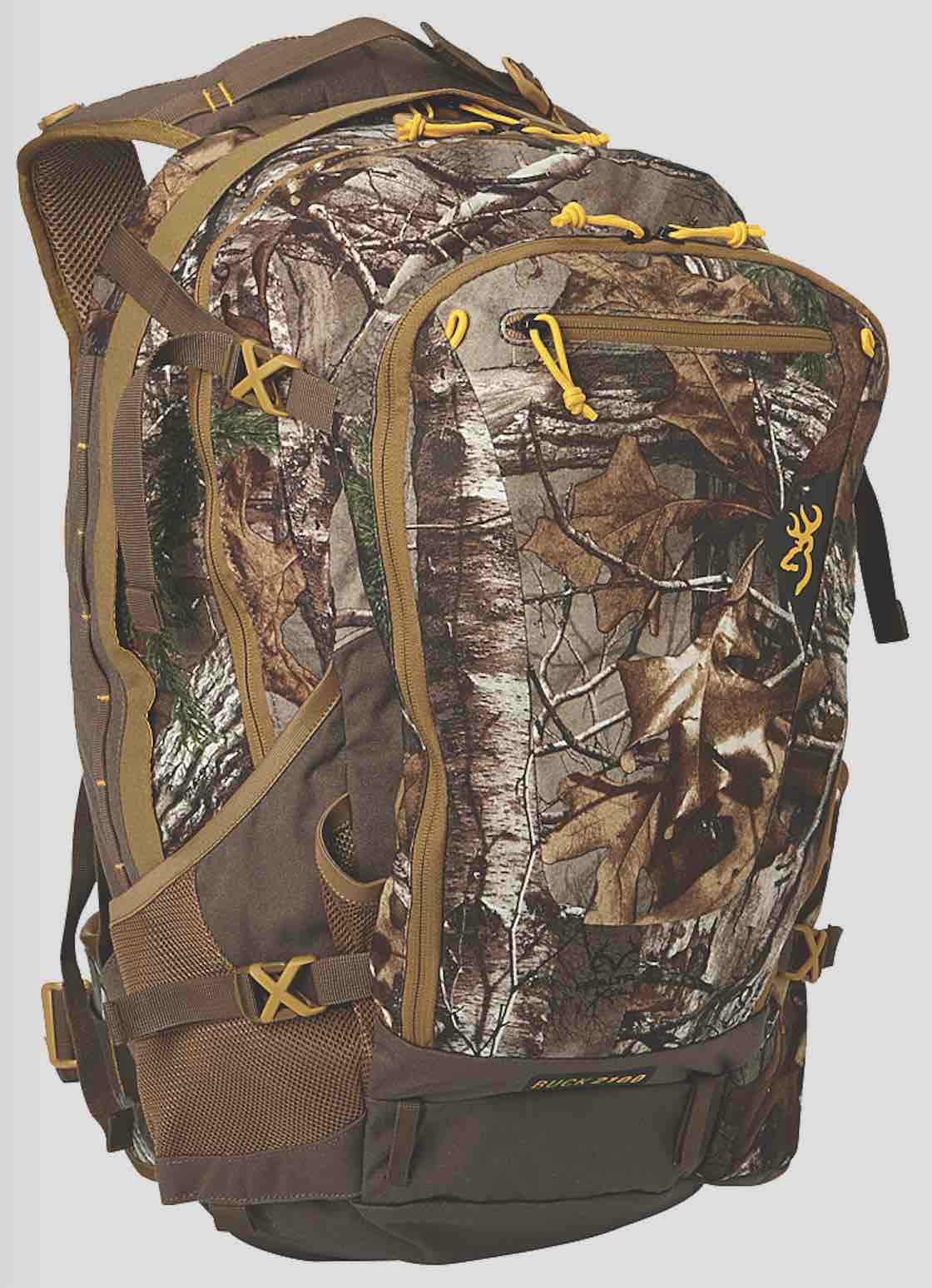 Browning Buck 2100
Browning Buck 2100
(866) 453-1098; www.browninglifestyle.com
Pack Specs: 2,100 cubic inches; 3 pounds; hydration-reservoir compatible; $130
Comfort/Adjustment
A price-point daypack, the Buck 2100 boasts adjustable bottom shoulder straps, an adjustable waist belt and a chest strap. The 2100 had no upper shoulder-adjustment straps, which, with a heavier load, made it a tad more difficult to place the weight perfectly on the hips. The waist belt is well-padded, as is the lower-back support area. The mid-back section is not padded, but I found this to be a great air-circulation move. With the upper- and lower-back sections padded and the mid-back section not, there’s just enough space for air to move through. Twenty-five pounds proved to be a bit much for a 5-mile off-road jaunt. The pack handled the weight just fine, but my shoulders and traps were a tad sore.
Pockets
This is the area where the Buck 2100 really shines. It has a lot of pockets. The single waist-belt pocket is large and features a pair of elastic mesh pockets inside. I found these perfect for a bottle of wind checker and a headlamp. Because designers of this pack understand how much hunters use this particular pocket, the closure on this waist-belt pocket boasts a Hypo-Sonic slide zipper system. With its rubber-coated track, it’s completely silent — great feature. A large outside mesh pocket (adjustable with a strap) is found on the left side of the pack, and there’s a padded pocket (enclosed but open on the top) on the right. I found this strap-adjustable pocket to be an ideal place for a spotting scope. The first front pocket is small but perfect for items like face paint and field wipes. The second front pocket showcases a labeled front gear organizer (more on this later), as well as a single mesh pocket and solid fabric pocket. The front pocket does unbuckle at the top, making room between the front pocket and the second front pocket. I found this space great for toting extra apparel. I could attach my bow here as well, though I wasn’t crazy about the way the pack held it. The third front pocket is large and spacious, and it features a trio of elastic mesh pockets as well as a large pocket with an elastic band at the top that separates the it, creating two large pockets. The fourth front pocket (no, you’re not reading that incorrectly) is fixed with a hydration-reservoir section and two elastic mesh pockets. This pocket is also fitted with Browning’s labeled pack organizer system.
Durability
This pack, especially with its economical price point, gets the durability nod. Some of the knots on the nylon cord that run through the pack’s many zippers came undone, but besides that, this pack was a warrior. It survived the cliff fall, and I had zero issues with the zippers and buckles.
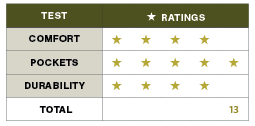 What I Loved
What I Loved
Even being a seasoned pack user, I really liked the attention to organization Browning placed on the Buck 2100. The inside-the-pocket labeled gear organizer charts are great. Not only did the charts make me think of a few things I often forget to tote, but they also told me exactly what pockets Browning designed for specific gear items.
Ideal For:
This pack is a solid spot-and-stalk option if you’re not carrying too much of a load. I also found it a great treestand and ground blind option.
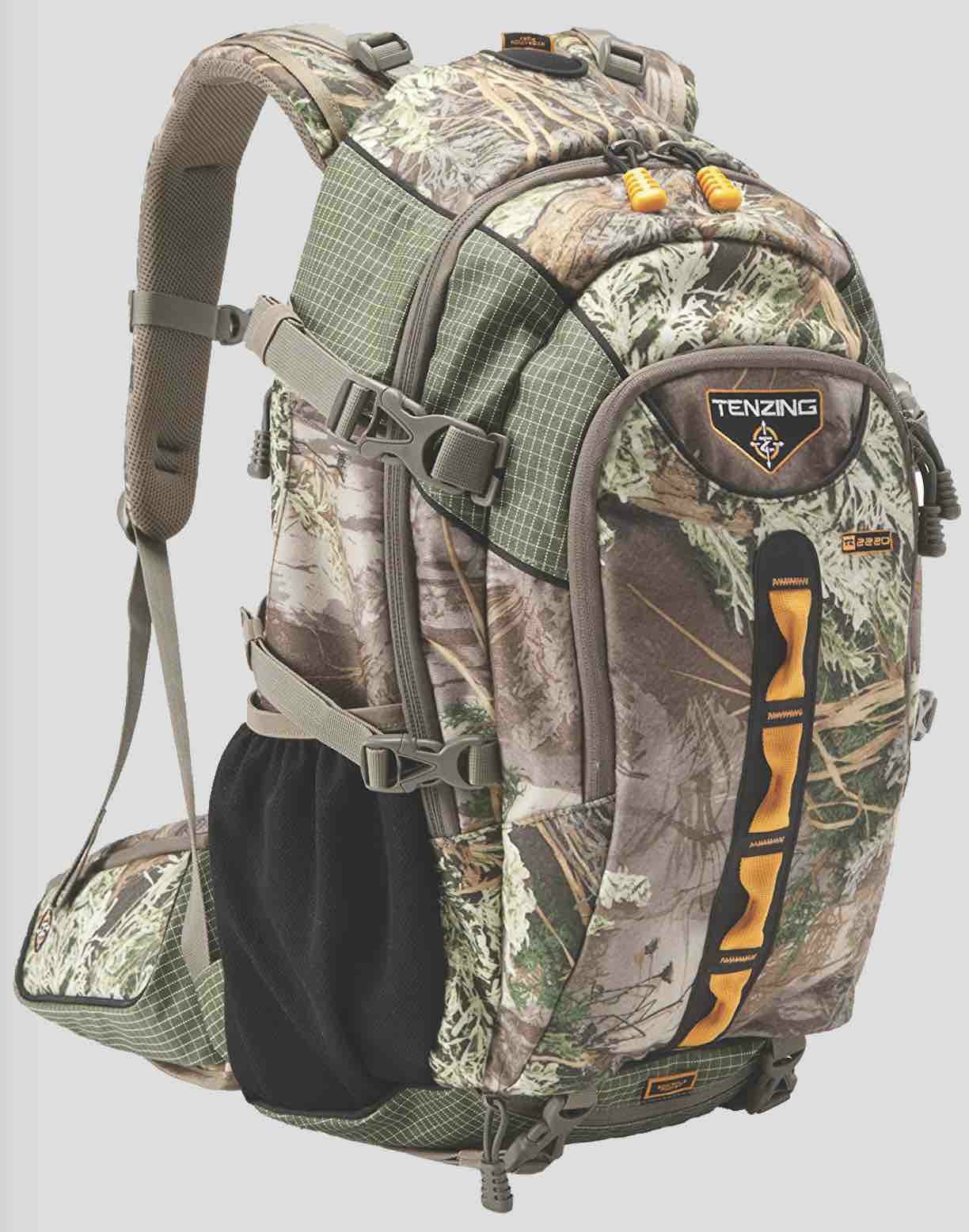 Tenzing 2220
Tenzing 2220
(800) 226-9868; www.tenzingoutdoors.com
Pack Specs: 2,228 cubic inches; 4 pounds; hydration-reservoir compatible; $220
Comfort/Adjustment
The padded and easily adjustable waist belt sports a raised and extremely comfortable padded lower-back section. Shoulder adjustment is basically infinite, allowing the user to situate weight perfectly on the hips or hug the pack tightly to the back. Of course, the pack sports a chest strap as well. A pair of raised pads running vertically up the right and left side of the pack increase comfort while boosting air flow. This was without question one of the coolest (in terms of air flow) packs I toted. In addition, the internal aluminum stay frame offers support and provides a sense of appreciated rigidity I wouldn’t want to be without. The pack handled the weighted 5-mile jaunt with ease.
Pockets
The TZ2200 gets my waist-belt pocket nod. The pair promise easy access and provide plenty of storage space on the waist. There are also a pair of mesh side pockets and a pair of zippered side pockets. At first glance these pockets are barely noticeable, but they’re actually quite spacious. The first front pocket is lined with four lateral compression straps, which I found handy when attaching additional items to the pack. It also boasts a small zippered mesh pocket along with a pair of elastic mesh pockets. The second front pocket (the main pack compartment) offers a hydration-reservoir slot. Other than that, the pocket is big and wide open. The pack is also fitted with a foldout rain cover as well as foldout bow-holder pocket. I did appreciate the fact that the bow-holder pocket was stretchable and conformed to most cams, but I could live without the buckle closure system designed to go over the bottom cam. As pockets go, the TZ2200 is a meat-and-potatoes kind of pack. It boasts plenty of storage space, but it doesn’t line that space with meaningless pockets. I like that.
Durability
The fabric of this pack handled the cliff tumble like a champ, but a pair of the female buckle ends did crack. Besides that, the pack held up well. The zippers were flawless, never sticking or chattering along.
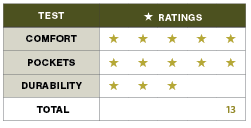 What I Loved
What I Loved
This pack was a pillow. During my 5-mile hike, I had to stop and try to find some area of body discomfort. I couldn’t. Even weighted with 25 pounds of gear, the pack was easy on the shoulders, rode perfectly on the hips and was cool against the back. I also appreciated its pleasing-to-the-eye appearance and the fact that Tenzing was able to give this diminutive pack such great volume.
Ideal For:
This pack would be great for off-the-beaten path treestand and ground blind hunting. It’s also a solid spot-and-stalk pack.
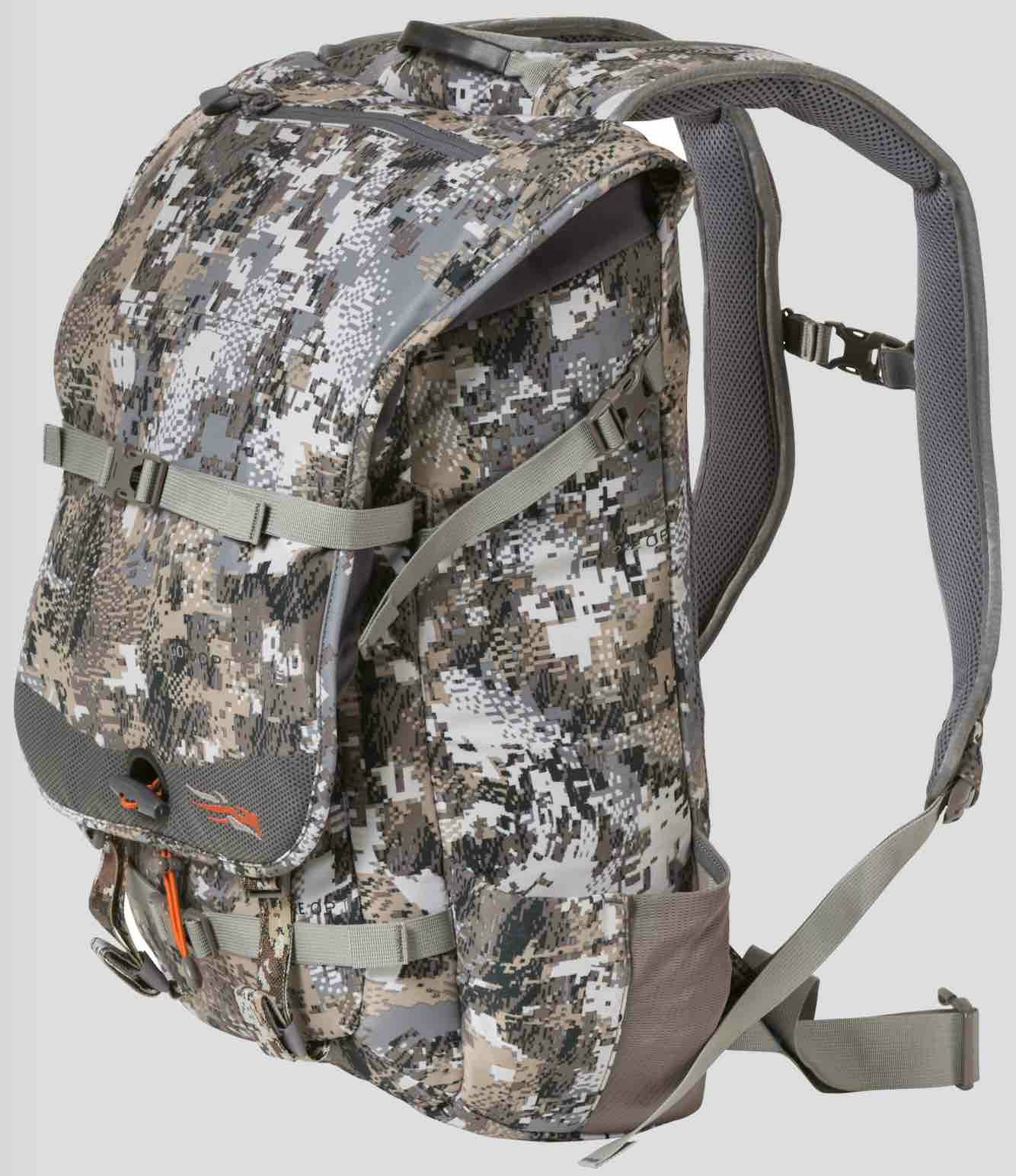 Sitka Tool Box
Sitka Tool Box
(877) 748-5247; www.sitkagear.com
Pack Specs: 1,800 cubic inches; 2.7 pounds; not hydration-reservoir compatible; $249
Comfort/Adjustment
Sitka makes a number of daypacks, and the Tool Box is without question geared toward the pursuit of white-tailed deer. With that noted, I will say the pack remained at least semi-comfortable throughout my 5-mile trek. The biggest reason for this is the padded shoulder uppers and breathable, padded back. The pack does sport a no-pocket, no-pad waist belt and chest strap. In addition, the shoulder straps only offer adjustment at the bottom of each strap.
Pockets
The Tool Box features a pair of half-mesh/half-fabric side pockets that are open at the top. The main flap on the Tool Box sports a small zippered pocket with a key ring holder, and I found this pocket ideal for camo face paint, wind checker and the like. The main compartment is the big story with the Tool Box. The inside of the front flap is lined with three zippered mesh pockets. The top of the flap boasts a metal ring that the user can attach to a tree hook or limb to hold the Tool Box open. This means fast, organized access to those items you need. The main compartment is divided by a stretchable piece of fabric that splits the main compartment into two different sections. The back section is lined with a pair of stretchable pockets, as are both sides of the main compartment. The pack also boasts a number of outside straps that allow the user to tote extra gear. I found each pocket to be purposeful.
Durability
For more of a whitetail-specific daypack, the Tool Box took the tumble like a champ. Sitka makes great gear, and it was obvious the manufacturer didn’t skimp when constructing this quality daypack. I had zero buckle or zipper problems, and I appreciated the rubber-coated zipper rings that allowed easy access to each part of the pack, including many of the inside pockets. I also liked the adjustable toggle closure that slips through the metal hanging ring and keeps the main compartment flap from, well, flapping about.
 What I Loved
What I Loved
It was obvious that each and every pocket was designed with a specific purpose in mind. I loved that. I also appreciated the fact that the pack boasted a number of straps and holes from which to hang it from a tree.
Ideal For:
This is a fantastic treestand pack. Period.
Final Thoughts
That’s a wrap! Now go take a look at these packs and decide which, based on your bowhunting needs, will be your over-the-shoulder companion this archery season.
I’d love to hear your thoughts on this field test. Was it helpful? What could we do different? Have you had in-the-field experiences with any of these daypacks? If so, how did the particular pack perform for you? In addition, I’d really enjoy, if you decided to purchase one of these innovative shoulder huggers, to hear how it worked out for you. Drop me a line at jace.bauserman@grandviewoutdoors.com.
